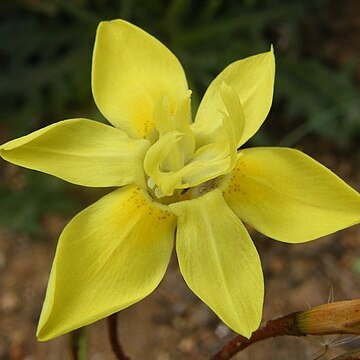Plants 250-500 mm high, flexuously branched. Corm 15-20 mm diam.; tunics dark brown, ± woody or becoming fibrous, sticky-bituminous on inner surfaces. Stems with up to 3 branches at most aerial nodes, viscous below nodes, with cauline entirely sheathing leaves ± obtuse to truncate. Foliage laves 2, lower basal, upper inserted at lowest aerial node, linear, falcate to trailing, occasionally loosely coiled. Rhipidial spathes green, becoming dry and conspicuously veined with age, apices acute to obtuse, brown, occasionally lacerated, 25-40 mm long, subequal or outer only slightly shorter. Flowers fugaceous, usually pale to deep yellow with outer tepal limbs with darker yellow nectar guides at bases often speckled with black (rarely blue-mauve with white nectar guides), sweetly scented; outer tepals 23-31 x 8-12 mm, claws 5-8 mm long, limbs ± spreading to reflexed up to ± 35º; inner tepals 20-25 mm long, oriented as outer tepals. Filaments mostly 6-12 mm long, free but parallel and contiguous in a slender column, or united, diverging in upper 1-2 mm; anthers 4-7 mm long, yellow (rarely dark purple); pollen yellow (rarely red). Ovary ovoid, ± 6 mm long, usually at least partly exserted, style branches 4-9 mm long, crests 6-12(-15) mm long, lanceolate to linear, stigmatic appendage ± 1 mm long. Capsules ovoid, 10-13 mm long. Seeds angular-prismatic.
More
A corm or bulb plant. It grows 20-50 cm tall. There are 2 or 3 narrow leaves. They have a channel and are trailing. The flowers are large and yellow.
Cormous geophyte, 20-50 cm, stems sticky. Leaves 2 or 3, linear, channelled and trailing. Flowers fairly large, yellow (rarely mauve).

